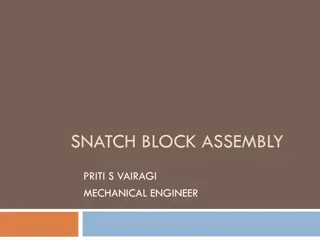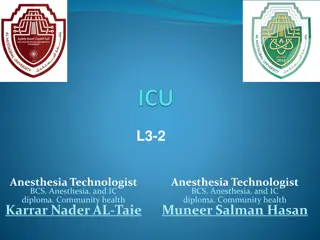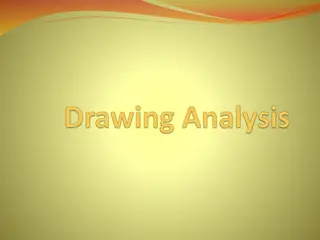Mechanical Engineering Curriculum Changes Fall 2024
The Mechanical Engineering curriculum is undergoing significant changes for Fall 2024, providing opportunities for students to adapt to a revised program. Changes include an improved design sequence, condensed math courses, and enhanced professional preparation with added elective options and a new
1 views • 12 slides
Overview of Mechanical Engineering Department and Institutes
Welcome to the Department of Mechanical Engineering! This presentation provides an overview of the department, highlighting key areas such as electromobility, institutes like FAPS and FMT, and their research and teaching focuses. Explore the interdisciplinary courses, research areas, and academic of
2 views • 13 slides
Development and Qualification of Small Scale Test Technologies in Structural Engineering
Small Scale Test Technologies (SSTT) play a crucial role in determining the mechanical properties of materials used in engineering applications. This roadmap focuses on the importance of testing relevant volumes to ensure transferability to real-world structures. It discusses the need for consistent
0 views • 26 slides
NNbar Annihilation Detector Mechanical Design Proposal
This proposal outlines the mechanical design considerations for the NNbar Annihilation Detector, highlighting practical concerns and proposed changes to the baseline design. Topics cover the structure support, component weights, installation challenges, and optimizations for improved detector perfor
2 views • 27 slides
Understanding Basic Forms of Energy
Energy exists in various forms such as light, heat, sound, electrical, chemical, and mechanical. These different forms of energy play a key role in causing changes in matter and enabling movement in various objects. From mechanical energy related to motion and position to chemical energy stored in m
5 views • 24 slides
Understanding Mechanical Ventilator Sensors and Actuators
Explore the essential components of mechanical ventilators, including sensors like pressure and flow sensors, actuators, and oxygen sensors. Learn about the functions and characteristics of these sensors and how they contribute to the operation of mechanical ventilators designed to assist patients w
6 views • 20 slides
Understanding Downstream Processing in Bioprocessing
Downstream processing plays a crucial role in bioprocessing after fermentation, focusing on separating, purifying, and packaging the final product. It involves stages like cell disruption, removal of insoluble particles, product recovery, and purification methods such as filtration and centrifugatio
0 views • 38 slides
Welding Processes and Equipment Settings in Cast Iron Welding - EASA Electro-Mechanical Authority 2021 Conference
Explore the essential aspects of welding processes and equipment settings in cast iron welding discussed at the EASA Electro-Mechanical Authority 2021 Conference in Myrtle Beach, SC. Topics covered include SMAW, GTAW, GMAW, FCAW, safety reminders, proper machine settings, preheating, peening, and AW
2 views • 16 slides
Overview of Farm Power Sources and Utilization in Agriculture
Farm power sources in agriculture include human, animal, mechanical, and renewable energy. Human power is costly but versatile, while animal power is traditional and provides manure. Mechanical power from tractors and engines is efficient. India's farm power sources reflect a mix of traditional and
0 views • 12 slides
Understanding Force Transmissibility in Mechanical Systems
Force transmissibility in mechanical systems is crucial for analyzing the relationship between applied forces and resulting vibrations. This outline covers key concepts such as base excitation, motion transmissibility, and rotating unbalance, providing insights into how forces are transmitted and am
0 views • 16 slides
Understanding Pulley Systems in Mechanical Engineering
Pulleys play a crucial role in mechanical engineering, offering fixed and movable designs that aid in changing the direction of hoisting appliances. Different types, including fixed, movable, and multiple pulley systems, provide mechanical advantage and stability in lifting loads. Utilizing multiple
1 views • 11 slides
Advanced Hybrid Electrochemical Machining Processes
Hybrid electrochemical machining processes combine chemical dissolution and electrochemical dissolution mechanisms with mechanical or thermal assistance to achieve high material removal rates and improved surface quality. Techniques such as laser-assisted chemical etching and ultrasonic-assisted mac
1 views • 26 slides
Advanced Treatment Processes for Faecal Sludge Management
Treatment processes for faecal sludge management involve various stages including preliminary treatment, primary treatment, secondary treatment, and tertiary treatment. Each stage employs mechanical, biological, and chemical processes to separate, decompose, and remove contaminants from the sludge,
0 views • 7 slides
Understanding Mechanical Devices for Movement
Delve into the world of mechanical devices used to generate movement, focusing on levers as a critical mechanism for creating mechanical advantage. Learn about the different classes of levers, their applications, and how they enhance efficiency in various tools and equipment. Explore concepts such a
0 views • 8 slides
Introduction to Mechanical Engineering: Exploring Career Opportunities and Roles
This content delves into the world of mechanical engineering, covering topics such as the characteristics of students interested in engineering, the distinction between engineers and scientists, and the functions of engineers in research. It also provides insights into the differences between engine
6 views • 41 slides
TVR and MVR Operations and Analysis in Dairy Engineering
TVR (Thermo Compressor Vapour Recompression) and MVR (Mechanical Vapour Recompression) are two methods used in dairy engineering to compress vapors for various processes. TVR utilizes the kinetic energy of steam jets while MVR employs mechanical compression through compressors. The advantages and di
4 views • 13 slides
Evolution of Arcade Games: From Mechanical to Digital (1870-1977)
Explore the fascinating journey of arcade games from mechanical and electro-mechanical devices in the 19th century to the birth of digital games in the mid-20th century. Witness the transition from coin-operated amusement machines to early digital arcade games and home consoles, shaping the gaming i
0 views • 37 slides
ME 4182 & GT 4823: High-profile Mechanical Design Course at Georgia Tech
Spearheading an innovative experiment, ME 4182 & GT 4823 aim to redefine mechanical design education by fostering interdisciplinary collaboration, problem-solving skills, and real-world applications. Students engage in team-based projects to design mechanical solutions, present detailed specificatio
0 views • 36 slides
Department of Mechanical Engineering DAB Meeting Presentation Summary
The Department of Mechanical Engineering held a DAB Meeting Presentation on 23rd January, 2021. The meeting agenda included topics like approval of previous minutes of meeting, academic progress of students, online teaching activities, faculty contributions, and more. The minutes of the meeting disc
1 views • 36 slides
Understanding Mechanical Injuries: Types, Classification, and General Principles
Mechanical injuries encompass a variety of harms caused to the body, mind, reputation, or property. These injuries can be classified into medical, legal, and medico-legal categories based on factors like intentionality. The types of mechanical injuries range from blunt force trauma to thermal, chemi
0 views • 79 slides
Understanding Weathering and Erosion Processes in Chapter 14
Weathering and erosion are natural processes that break down rocks through mechanical and chemical means. Chapter 14 explores the different types of weathering processes, including mechanical weathering like ice wedging and abrasion, as well as chemical weathering from reactions with substances like
0 views • 50 slides
Understanding Programs and Processes in Operating Systems
Exploring the fundamental concepts of programs and processes in operating systems, this content delves into the definitions of programs and processes, the relationship between them, the components of a program, what is added by a process, and how processes are created. The role of DLLs, mapped files
0 views • 22 slides
Understanding Mechanical Ventilation in Anesthesia Practice
Anesthesia technologists play a crucial role in managing artificial ventilation, including concepts like Invasive Positive Mechanical Ventilation (IPMV), Fraction of Inspired Oxygen (FIO2), Tidal Volume (VT), Peak Flow Rate, Respiratory Rate, Minute Volume (VE), I:E Ratio, and more. They monitor and
0 views • 27 slides
Understanding Machines: Making Work Easier and Mechanical Advantage
Machines are devices that simplify work by increasing force, decreasing force, increasing distance, or changing direction. They operate by transferring energy and work from input to output, with mechanical advantage enhancing force ratios. This summary explores the principles of machines, work done,
0 views • 10 slides
Understanding Mechanical Ventilation in Anesthesia Technology
Mechanical ventilation plays a crucial role in assisting patients with breathing difficulties by delivering oxygen and removing carbon dioxide. It involves two primary types: Negative Pressure Ventilation (NPV) and Positive Pressure Ventilation (PPV). NPV helps patients with conditions like chronic
0 views • 19 slides
Newton's Interpolating Polynomials in Mechanical Engineering
Explore Newton's interpolating polynomials in the context of Mechanical Engineering, specifically focusing on numerical methods and interpolation techniques. Dr. Mohamed El-Shazly, an Associate Professor of Mechanical Design and Tribology, guides students through the concepts and applications of New
0 views • 17 slides
Fundamentals of Environmental Thermal Engineering in Mechanical & Aerospace Engineering
Explore the key concepts of environmental thermal engineering in Mechanical & Aerospace Engineering, covering topics such as the Carnot cycle, actual vapor-compression cycle, principles of the vapor-compression cycle, Carnot heat engine, refrigeration cycle, and coefficient of performance. Understan
0 views • 51 slides
An Overview of Finite Element Method in Mechanical Engineering
Finite Element Method (FEM) in mechanical engineering is a powerful numerical technique involving dividing a domain into finite elements, establishing relations between variables, and assembling elements to analyze a system. This method is fundamental for solving one-dimensional problems and approxi
0 views • 63 slides
Anupam Saxena's ME 251 Lecture III - Part and Assembly Drawings: Example II
Anupam Saxena, a professor in Mechanical Engineering at the Indian Institute of Technology Kanpur, presents a detailed study on part and assembly drawings in ME 251 Lecture III. The lecture covers examples such as non-return valves, threaded fasteners, bolts, nuts, sizes, proportions, and representa
0 views • 18 slides
Understanding Mechanical Properties of Nanostructured Materials
Nanostructured materials exhibit unique mechanical properties due to factors like grain boundary structure and dislocation movement. Reduction in grain size can enhance strength and hardness while reducing ductility. Nanomaterials may reach theoretical strength levels, significantly higher than sing
0 views • 23 slides
Understanding Machines: Calculating Mechanical Advantage and Efficiency
In the world of machines, understanding what a machine is, how to calculate Mechanical Advantage (M.A.), and Efficiency is crucial. Machines alter force, distance, or direction to make work easier but do not multiply work. By assessing input force, distance, and work alongside output force, distance
0 views • 17 slides
Understanding Robotics: Components, Joints, and Manipulators in Mechanical Engineering
Explore the world of robotics through an in-depth analysis of the key components, mechanical elements, manipulator joints, end-effectors, and types of robots used in production engineering and mechanical design departments. Learn about joints, links, degrees of freedom, and how robot manipulators ar
0 views • 22 slides
Robotics and Mechanical Design at Minia University
Explore the world of robotics and mechanical design at Minia University's Production Engineering and Mechanical Design Department. From the Kinematics of Two Industrial Robots to the renowned PUMA 560, immerse yourself in cutting-edge technology and innovative research led by experts like Dr. Ahmed
0 views • 13 slides
Understanding Mechanical Linkages in High-Performance Manufacturing
Explore the world of mechanical linkages, including the effects of friction on machine operation, operation of machine linkages, and the roles of cams and turnbuckles. Friction is discussed as a force affecting everyday tasks, while cams and camshafts are highlighted for their role in sewing machine
0 views • 8 slides
Introduction to Press Tools and Presses Classification
Press tools are specialized tooling used for various forming processes like blanking, piercing, shearing, bending, drawing, and more. Presses are classified based on power source, frame type, slide actuation method, and number of slides. Mechanical and hydraulic presses are distinguished by power so
0 views • 20 slides
Understanding Mechanical Ventilation in COPD Exacerbation
In a case of a 64-year-old woman with COPD exacerbation, managing respiratory distress is crucial. Initiating systemic corticosteroids, doxycycline, and nebulizers while closely monitoring the patient is important. However, in cases where non-invasive ventilation is ineffective, the patient may requ
0 views • 22 slides
The Work of Art in the Age of Its Technical Reproducibility by Walter Benjamin
Walter Benjamin discusses the impact of technological reproduction on art, specifically the loss of aura through mechanical processes. He emphasizes the significance of art's unique existence in time and space, examining how modern art has evolved in response to new modes of reproduction. Benjamin's
0 views • 18 slides
Overview of Metal and Sand Casting Processes
Metal and sand casting are ancient manufacturing techniques dating back to 4000 B.C., allowing the production of complex shapes in various metals. The casting industry produces millions of kilograms of castings annually, primarily using materials like gray iron, ductile iron, aluminum alloys, and co
0 views • 13 slides
Main Manufacturing Processes to Produce PM - Mechanical, Chemical, Electrochemical
The process of producing PM involves various manufacturing processes such as mechanical grinding and milling, physical-mechanical production methods, chemical production methods, and electrochemical production methods. Mechanical processes include grinding and milling using jaw crushers, hammer grin
0 views • 12 slides
Understanding Production Drawings and Mechanical Drawing Reading
Production drawings, also known as working drawings, provide essential information for manufacturing machines or structures. They include dimensions, material details, assembly instructions, and more. This legal document ensures manufacturing standards adherence and serves as a guide for production.
0 views • 20 slides







































